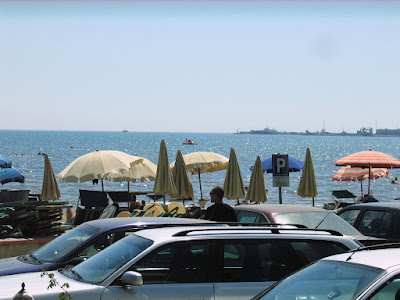
The entire place was refurbished. Like all new constructions that stand out from the air, or from the ground, as one travels above or around Albania, water tanks, and solar panels are noticeable on every roof.

This establishment contains a modern hotel, a restaurant that surrounds a large pond with ducks and swans, and thousands of ‘koran’ fishes.



The area of Pogradeç is blessed with a natural, pure , and never ending supply of water from the surrounding mountains. This place, called ‘Ritja e Koranit’ takes advantage of this resource and raises his “precious" korans on its own premises. Its man built pond is fed by an entire system of water viaducts with a variety of gates that separate the fishes according to their sizes and stages of development. The largest ones end up in the pond from which they are retrieved for cooking at the latest moment.

The 'koran', called by some a trout, is not a salt water fish, although it belongs to the salmon family; it’s pink in color and absolutely delicious! It’s typical only of Lake Ohrid, and is not found anywhere else in the world, according to Unesco. This very large lake is shared between Albania and Macedonia, and it’s difficult to buy this fish elsewhere, even along the Macedonian side. On many occasions Queen Elisabeth has ordered a supply of this delicacy from Pogradeç, which was flown to her all the way to England.

At the border, private vehicles must purchase insurance coverage for all passengers, using euro, and then proceed, after a short neutral ground, through the Macedonian customs and passport control. The currency of this state is the dinar.

The lake views accompanied us along a nicely paved, but narrow, winding road, while we headed toward the town of Ohrid, which lends its name to the lake. Midway we visited "Shen Naum" park and tourist resort, which is an exact replica of "Volorec" in Albania (mentioned in part 1 below).

We found this place thriving with visitors from everywhere, and we climbed the hilly grounds to also see the old Orthodox church and monastery, now converted into a hotel, complete of facilities such as a gym, massage rooms, and a health spa.


On the ground a few peacocks, with their screeching calls and their gorgeous plumage, were attracting much of the visitors' attention.


Beyond one of the old gates, some refreshing water cascades, and further down the hill a calm and cool small lake with its own touring boats, and rustic cafes.




After Ohrid, we proceeded to Struga, a very Albanian town in Macedonia, and located along the lake, which by now we had circled around for almost 3/4 of its shores. Here, the lake feeds a large river that crosses the town, where we enjoyed some ice cream.

As we reentered Albania via the border pass of Qafe Thane, located 80km SE of Tirana, I realized that we actually encircled Lake Ohrid in its entirety.
We stopped for a late lunch on Albanian soil, where the old 'bunkers' came very much back into sight.

In the new restaurant of Hotel Odessa, along the highway, we found the waiters scrambling to serve all the unexpected customers that included an entire busload of French seniors.

The return to Tirana was shortened by about 40km, but it entailed driving over high mountain, very narrow, steep roads, many, many sharp curves, and no guard railings anywhere. Although my friends didn't particularly care to drive this route, which requires special concentration on the part of the driver, they took it to avoid the expected heavy traffic and road work when getting near the capital.
At one point, they even dared to make a brief stop along the edge of the road to buy cherries, for which this area is well known. They are sold by local people or children, who pack them around live tree branches in a very unusual way, using fine nylon thread, one by one.

They are sweet and delicious and the perfect ending of a wonderful weekend!













































